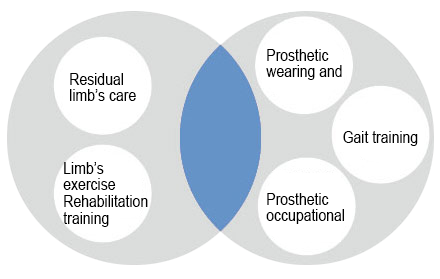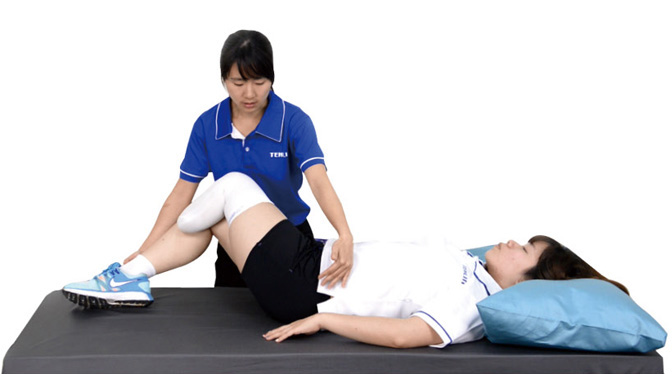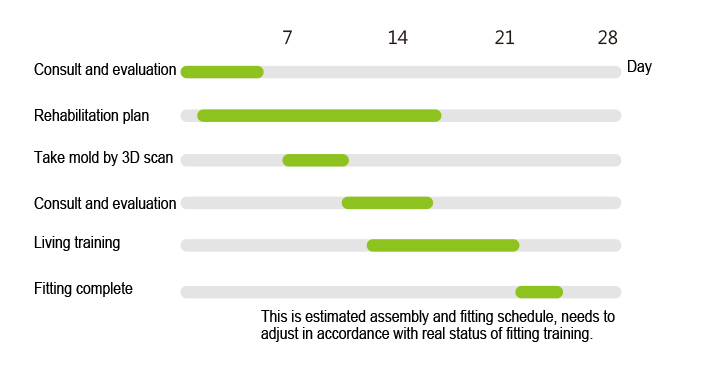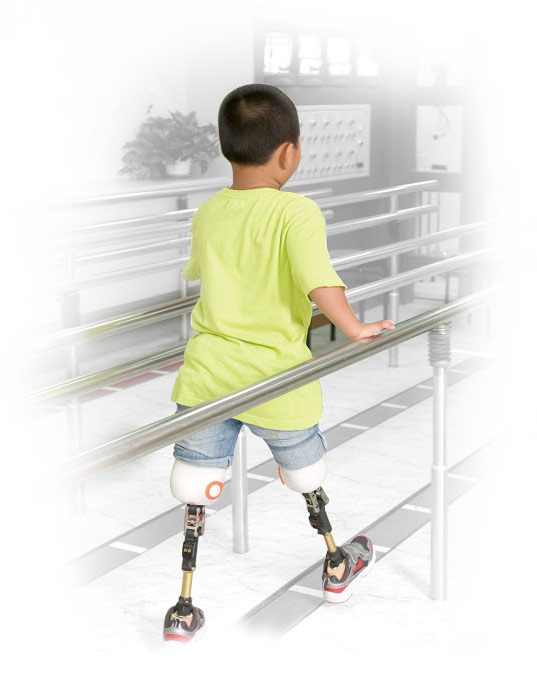LOWER LIMB PROSTHETIC REHABILITATION TRAINING
LOWER LIMB PROSTHETIC REHABILITATION TRAINING
Losing a lower limb has a very big impact to a person’s life, the purpose of TEH LIN’s rehabilitation system is to use the most appropriate and technologically advanced components with TEH LIN’s 3D central socket creation system, integrating the experience and intelligence of the entire technical team focused on the goal of helping the patient recover their function, achieve their potential, and pursue their dreams (Explore New Life).
Rehabilitation training planRehabilitation training planAmputation is the result after a serious trauma and surgery, TEH LIN provides the patient compassionate and effective nursing care after surgery, such as using elastic bandages to shape and protect the limb or a post-operative prosthesis to maintain activity and condition the limb. This can be provided a few hours or days after the surgery. A successful rehabilitation outcome is determined by many factors. For the amputee who lost their limbs, rehabilitation is a cooperative team approach involving many people that are all committed to the amputee’s success. Ideally, you will be the member of the team which includes family, friends, doctors, therapist, prosthetist, even a psychologist. Although the key person is the patient, every team member’s profession and instruction is also very important. Not everyone can complete a comprehensive prosthetic rehabilitation plan, you can discuss the most effective arrangement with your prosthetist. The prosthetic rehabilitation process includes two portions: (1) The rehabilitation of the residual limb; (2) The functional training with the prosthesis. The rehabilitation of the residual limb can be separated into the physical therapy of the limb and Exercise Rehabilitation Therapy, abbreviated “ERT”. ERT means that after putting on the prosthesis, the prosthetist will provide instruction on how to use the prosthesis appropriately and effectively. The prosthetist will help you make a suitable and effective rehabilitation plan with physical therapy, ERT, and the functional training with the prosthesis. |
Molding of the residual limb, modification, and fabrication of the socketMolding of the residual limb, modification, and fabrication of the socketOur experienced prosthetic technicians will carefully and deliberately measure and take a mold of your residual limb. Using plaster bandages the technician will carefully wrap your limb and once this hardens a negative mold will be created that is the exact size and shape of your limb. TEH LIN’s Central Socket Fabrication Center will use years of experience and advanced skills to create the most appropriate socket that will fit your limb precisely and comfortably. After the fabrication process is complete the prosthetist will fit you with a durable and beautiful socket. When your residual limb and physical condition are suitable, TEH LIN’s prosthetic technicians can also use the newest globally available scanning technology to capture the shape of your residual limb. Using an advanced technology laser scanner to convert the shape of your residual limb into a 3D image for the computer and directly sending this to TEH LIN’s Central Socket Fabrication Center for modification of the digital model and fabrication of the socket. This system is very convenient, fast, and precise. |
Prosthetic Life TrainingProsthetic Life TrainingAs a new amputee begins with either a rehabilitation prosthesis or their initial prosthesis, the first goal of the physical therapy process will be to go from a sitting to standing position safely. When the patient is able to safely stand, with the use of the parallel bars the initial prosthetic alignment will be performed. Next, the patient will begin to learn basic weight shifting and balance activities. The purpose of these basic activities and exercises will allow the patient to better understand the necessary weight shifting required during ambulation. All of these activities are always performed in the safety of the parallel bars and under the supervision of the prosthetic technician. During the initial training a significant amount of time will dedicated to insuring the patient is able to independently put on and take off the prosthesis properly. Next the gait training process will begin. This will begin slowly as the residual limb becomes more accustom to the weight bearing process. Gait training will be very deliberate and detailed so the patient can walk safely and with the proper weight shifting required. During this time the prosthetist will perform the dynamic alignment of the prosthesis. It is important to strengthen specific muscles that will allow for better control of the prosthesis and a more natural and beautiful walking style. As gait training progress’ specific activities, such as walking up and down stairs, getting dressed, or getting in and out of vehicles will be covered. It is very important to observe and take care of your residual limb during the training and rehabilitation process. Ignoring a small problem or not asking any questions could develop into a larger issue or result in unnecessary discomfort. During the training process the prosthetic technician will help you understand the normal physiological changes that will occur with your residual limb and how to manage these changes with proper use of prosthetic socks. Also, proper residual limb hygiene, as well as washing and caring for your prosthesis will be covered. |
Long-term rehabilitation therapy
Long-term rehabilitation therapy
Prosthetic Rehabilitation therapy is not only for new amputee and new prosthetic patients, but it can also be helpful for long term prosthetic users. A new prosthetic user is encouraged to have a follow up appointment with the prosthetist within 6 months after rehabilitation therapy has been completed. This is necessary to maintain a proper fit of the socket as the residual limb changes significantly during the first year of full time use. Long term users should have a checkup appointment at least once a year. It is always recommended to follow up with your prosthetist whenever any problems occur. This can help reduce the chance a small problem will develop into a larger issue. Some patients may only commit to a small portion of therapy and believe they can do well by themselves. We are committed to working with you to develop the best walking style and develop good walking habits that will be useful for the rest of your life and enable you to walk beautifully, naturally, and doing all the activities you desire. The focus of upper limb prosthetic therapy is centered on muscle strengthening, learning how the prosthesis functions, and applying this to specific activities that you will use in your daily life. Upper limb prosthetic therapy requires a deep commitment from the patient in order to master the tasks of daily living. We are dedicated to helping you achieve this success and gain the most from your prosthesis. For all prosthetic patients we recommend routine contact with the prosthetist for assistance, inspection, and any other issues or questions that may be needed.








